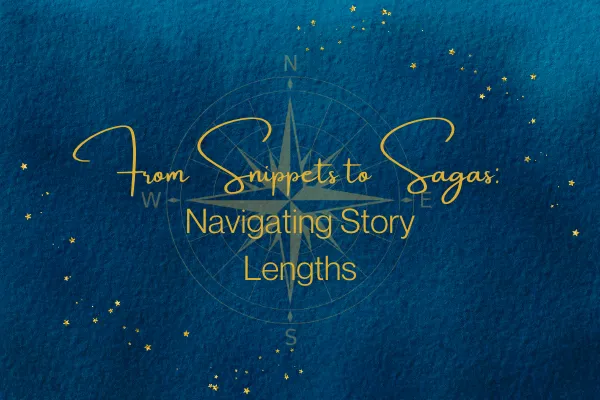
From Snippets to Sagas: Navigating Story Length
From Micro Fiction to Novels: The Wonderful World of Story Lengths
Hello, story lovers! 📚✨
Today, we're diving into the delightful universe of storytelling, exploring the fascinating spectrum from bite-sized micro-fiction to expansive novels. Whether you’re a writer, reader, or both, understanding these different lengths can enrich your appreciation of the written word. Let’s embark on this literary adventure together!
---
1. Micro Fiction (up to 100 words)
Tiny Tales, Huge Impact
Microfiction is the essence of storytelling distilled to its purest form. In just a few sentences, these stories pack a punch, leaving a lasting impression. Despite their brevity, they can convey profound meaning and evoke strong emotions.
Example: “For sale: baby shoes, never worn.” – Often attributed to Ernest Hemingway, this six-word story has inspired countless interpretations and emotions.
Award-Winning Story: “Sticks” by George Saunders, a hauntingly brief piece featured in The New Yorker, is a perfect example of micro-fiction that resonates deeply.
https://www.unm.edu/~gmartin/535/Sticks.htm
---
2. Flash Fiction (up to 1,000 words)
Short, Sweet, and Memorable
Flash fiction stories are like literary amuse-bouches. They’re perfect for those moments when you want a quick but satisfying read. These stories often revolve around a single moment or concept, capturing the essence of a scene or a feeling in a few hundred words.
Example: “The Egg” by Andy Weir, a profound and thought-provoking story about reincarnation and the nature of life, which you can read in just a few minutes.
Award-Winning Story: “The Paper Menagerie” by Ken Liu, which won the Hugo, Nebula, and World Fantasy Awards, captures an entire world of emotion and culture within the span of a short story.
---
3. Short Stories (1,000 to 7,500 words)
The Sweet Spot of Storytelling
Short stories are a beloved format for many readers and writers. They offer enough space to develop characters and plot while still delivering a concise and powerful narrative. Perfect for those who enjoy a complete story in a single sitting.
Example: “The Lottery” by Shirley Jackson, a chilling tale that leaves a lasting impact and has been a staple in literature classes for decades.
Award-Winning Story: “Exhalation” by Ted Chiang, which won the Hugo Award, beautifully explores themes of time and memory in a futuristic setting.
---
4. Novelettes (7,500 to 17,500 words)
A Little More Room to Roam
Novelettes strike a balance between the brevity of a short story and the depth of a novella. They allow for more complex plots and character development, making them ideal for exploring intriguing concepts or worlds without committing to a full-length novel.
Example: “The Time Machine” by H.G. Wells, a classic science fiction tale that takes readers on a journey through time in a compact yet compelling format.
Award-Winning Story: “The Black God’s Drums” by P. Djèlí Clark, a Hugo-nominated novelette, transports readers to an alternate New Orleans, blending magic and history in an unforgettable way.
---
5. Novellas (17,500 to 40,000 words)
The Best of Both Worlds
Novellas offer a satisfying middle ground between short stories and full-length novels. They provide enough space to develop a rich narrative and explore complex themes without requiring the time investment of a longer book.
Example: “Animal Farm” by George Orwell, a powerful allegory that packs a punch in its relatively brief format.
Award-Winning Story: “Binti” by Nnedi Okorafor, winner of the Hugo and Nebula Awards, tells the story of a young girl’s journey across the stars and her struggle to find her place in a new world.
---
6. Novels (40,000 words and up)
The Full Immersion Experience
Novels are the heavyweights of the literary world, offering expansive canvases for epic tales, intricate plots, and deep character development. They invite readers to lose themselves in their worlds for hours or even days, providing a truly immersive experience.
Example: “Pride and Prejudice” by Jane Austen, a timeless romance that delves into the complexities of love, class, and society.
Award-Winning Story: “The Underground Railroad” by Colson Whitehead, which won the Pulitzer Prize and the National Book Award, takes readers on a harrowing journey through a reimagined American history.
---
Finding Your Story Length
Whether you’re a writer figuring out where to start or an avid reader looking for your next great read, understanding the different lengths of stories can open up new possibilities. From the swift impact of micro-fiction to the sweeping narratives of novels, there’s a perfect length for every story and every reader.
So, what kind of story are you in the mood for today? A quick tale to ponder over your morning coffee or a novel to get lost in for days? Whatever your preference, there’s a whole world of stories out there waiting for you. Happy reading and writing! 📖✨
---
What’s your favourite story length and why? Share your thoughts in the comments below!
Have you taken my quiz to determine what type of writer you are? Find out HERE!
